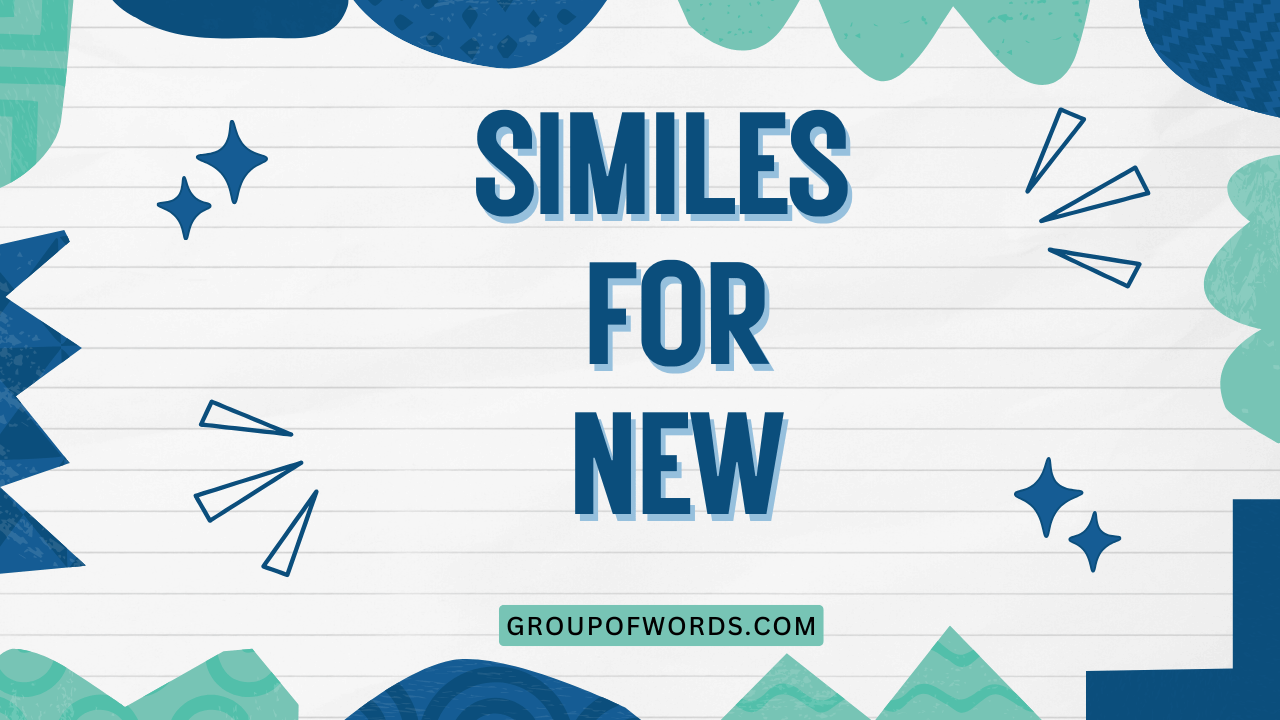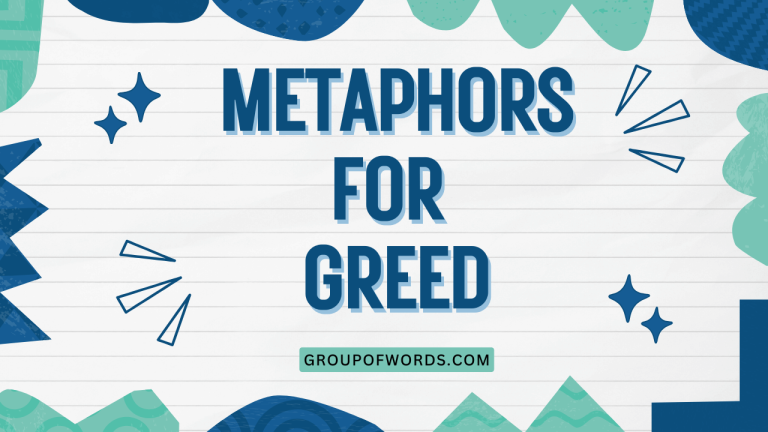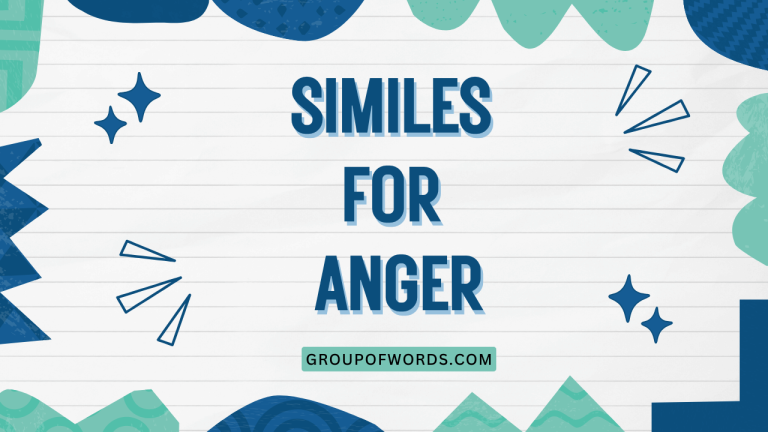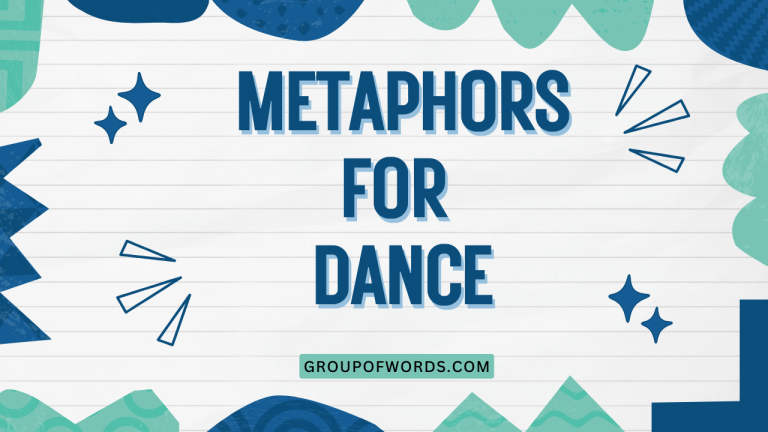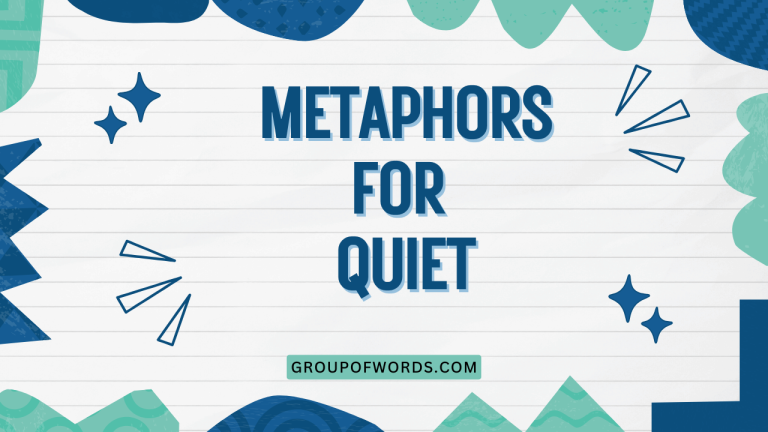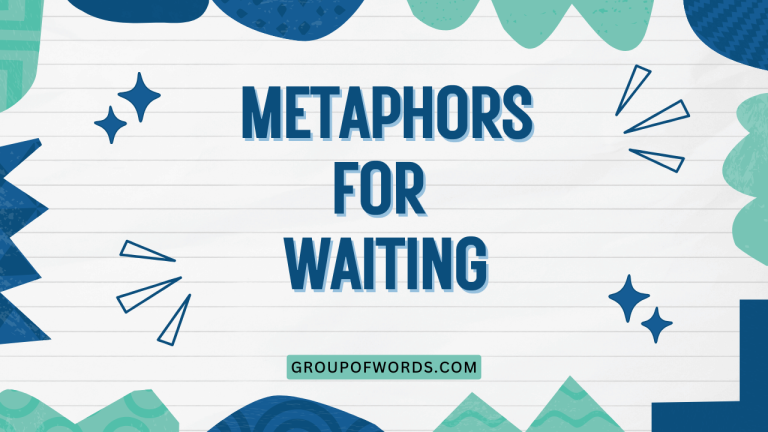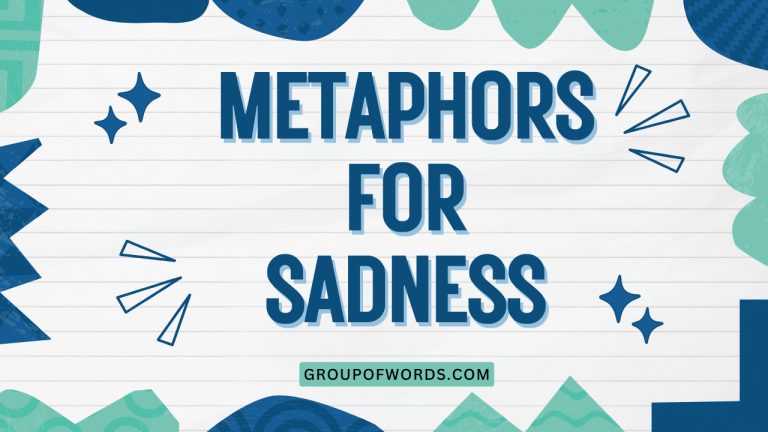Fresh as a Daisy: Mastering Similes for “New”
Similes are powerful tools in the English language, allowing us to create vivid and memorable descriptions by comparing one thing to another. When describing something as “new,” similes can add depth and color to our language, painting a picture in the reader’s mind and making our writing more engaging.
This article will explore a wide range of similes that can be used to describe “new” things, examining their meanings, contexts, and proper usage. Whether you’re a student looking to improve your writing skills or simply someone who enjoys the beauty of language, this guide will provide you with the knowledge and tools you need to master similes for “new.”
Understanding and using similes effectively can greatly enhance your communication skills, making your speech and writing more expressive and impactful. This article is designed for anyone looking to expand their vocabulary and gain a deeper understanding of figurative language.
By the end of this guide, you’ll be able to confidently use similes to describe “new” things in a variety of contexts, adding flair and precision to your language.
Table of Contents
- Definition of Simile
- Structural Breakdown of Similes
- Types of Similes for “New”
- Examples of Similes for “New”
- Usage Rules for Similes
- Common Mistakes When Using Similes
- Practice Exercises
- Advanced Topics in Similes
- Frequently Asked Questions
- Conclusion
Definition of Simile
A simile is a figure of speech that directly compares two different things using the words “like” or “as.” The purpose of a simile is to create a more vivid and descriptive image in the reader’s or listener’s mind. Similes are a type of figurative language, meaning they use words or expressions with a meaning that is different from the literal interpretation.
Similes function to enhance understanding and provide emotional context. By comparing something unfamiliar to something familiar, similes can make abstract concepts more concrete and accessible.
They also add color and depth to writing, making it more engaging and memorable. In the context of describing something as “new,” similes can emphasize aspects such as freshness, cleanliness, or novelty.
Similes are essential tools in both creative writing and everyday communication. They allow speakers and writers to express themselves in a more imaginative and impactful way, making their message more persuasive and memorable.
Understanding similes is crucial for mastering the nuances of the English language and for effectively communicating complex ideas.
Structural Breakdown of Similes
The basic structure of a simile consists of three main components: the subject, the linking word (either “like” or “as”), and the object of comparison. Understanding these components is essential for constructing and interpreting similes correctly.
- Subject: This is the thing being described or compared. In the context of this article, the subject is something that is “new.”
- Linking Word: This is the word that establishes the comparison, typically “like” or “as.” These words signal that a simile is being used.
- Object of Comparison: This is the thing to which the subject is being compared. The object of comparison should share a common characteristic with the subject, allowing for a meaningful and effective comparison.
For example, in the simile “as fresh as a daisy,” the subject is something being described as new, the linking word is “as,” and the object of comparison is “a daisy.” This simile suggests that the subject possesses the quality of freshness, similar to that of a newly bloomed daisy.
The effectiveness of a simile depends on the clarity and relevance of the comparison. A well-constructed simile should create a clear and memorable image in the reader’s mind, enhancing their understanding and appreciation of the subject being described.
Types of Similes for “New”
When describing something as “new,” different similes can be used to emphasize various aspects of its newness. These aspects can include freshness, cleanliness, novelty, and youthfulness.
Below are some categories of similes that effectively capture these different dimensions of “newness.”
Similes Emphasizing Freshness
These similes compare the newness of something to the freshness of natural elements, such as flowers, fruits, or morning air. They evoke a sense of purity, vitality, and unspoiled quality.
Examples include: “as fresh as a daisy,” “like a newly picked apple,” and “as crisp as morning air.” These similes are often used to describe food, experiences, or ideas that are invigorating and untainted.
Similes Emphasizing Cleanliness
These similes associate the newness of something with the state of being clean and unblemished. They suggest a sense of purity, order, and lack of wear or use.
Examples include: “as clean as a whistle,” “like a freshly laundered sheet,” and “as spotless as a new pin.” These similes are often used to describe objects, environments, or even reputations.
Similes Emphasizing Novelty and Uniqueness
These similes highlight the unique and unprecedented nature of something new. They emphasize the feeling of encountering something for the first time, often evoking a sense of excitement and wonder.
Examples include: “like a brand-new invention,” “as unique as a snowflake,” and “as novel as a first edition.” These similes are often used to describe ideas, technologies, or experiences that are groundbreaking and innovative.
Similes Emphasizing Youthfulness and Vigor
These similes connect the newness of something with the qualities of youth, such as energy, vitality, and potential. They suggest a sense of promise, growth, and unspent potential.
Examples include: “as young as the morning dew,” “like a newborn foal,” and “as vibrant as a spring blossom.” These similes are often used to describe people, projects, or ideas that are just beginning and full of potential.
Examples of Similes for “New”
To better illustrate the usage of similes for “new,” here are several examples organized by the categories discussed above. These examples demonstrate how similes can add depth and color to descriptions of new things.
Examples Emphasizing Freshness
This table provides examples of similes that emphasize the freshness aspect of something new. Each simile is designed to evoke a sense of purity, vitality, and unspoiled quality.
| Simile | Example Sentence |
|---|---|
| As fresh as a daisy | The air in the mountains was as fresh as a daisy, invigorating our lungs with every breath. |
| Like a newly picked apple | Her skin was like a newly picked apple, smooth and radiant. |
| As crisp as morning air | The new sheets felt as crisp as morning air, making the bed feel luxurious. |
| Fresh like a spring rain | The idea was fresh like a spring rain, washing away all the old doubts. |
| As dewy as the morning grass | Her eyes were as dewy as the morning grass, reflecting innocence and wonder. |
| Like a garden after the rain | The room felt like a garden after the rain, clean and refreshed. |
| As sweet as newly cut hay | The memory was as sweet as newly cut hay, bringing a smile to her face. |
| Fresh as a mountain stream | His perspective was as fresh as a mountain stream, clear and invigorating. |
| Like a just-baked loaf of bread | The house smelled like a just-baked loaf of bread, warm and inviting. |
| As pure as the driven snow | Her intentions were as pure as the driven snow, untainted by malice. |
| Fresh like a newly opened book | The adventure felt fresh like a newly opened book, full of untold possibilities. |
| As bright as a newly lit candle | Her smile was as bright as a newly lit candle, illuminating the room. |
| Like a field of sunflowers in bloom | The project felt like a field of sunflowers in bloom, vibrant and full of life. |
| As cool as the first day of autumn | The breeze was as cool as the first day of autumn, signaling a change. |
| Fresh as a new coat of paint | The room looked fresh as a new coat of paint, revitalizing the space. |
| Like a newly minted coin | The opportunity felt like a newly minted coin, full of potential value. |
| As pristine as an untouched forest | The land was as pristine as an untouched forest, teeming with life and untouched by human hands. |
| Fresh like a summer breeze | Her laughter was fresh like a summer breeze, light and carefree. |
| As invigorating as a dip in the ocean | The experience was as invigorating as a dip in the ocean, washing away stress and fatigue. |
| Like a newly hatched chick | The idea was like a newly hatched chick, fragile but full of potential. |
| As vibrant as a rainbow after a storm | Her energy was as vibrant as a rainbow after a storm, radiating hope and optimism. |
| Fresh as a page in a new diary | Each day felt as fresh as a page in a new diary, waiting to be filled with experiences. |
| Like a newly discovered star | His talent shone like a newly discovered star, bright and captivating. |
Examples Emphasizing Cleanliness
This table presents similes that highlight the cleanliness aspect of something new. These comparisons evoke a sense of purity, order, and lack of wear or use.
| Simile | Example Sentence |
|---|---|
| As clean as a whistle | The kitchen was as clean as a whistle after she finished cleaning. |
| Like a freshly laundered sheet | The bed felt like a freshly laundered sheet, crisp and inviting. |
| As spotless as a new pin | His uniform was as spotless as a new pin, reflecting his discipline. |
| Clean like a polished mirror | The surface was clean like a polished mirror, reflecting the light perfectly. |
| As pristine as a white canvas | The project was as pristine as a white canvas, ready to be filled with creativity. |
| Like a newly washed car | The car looked like a newly washed car, gleaming in the sunlight. |
| As clear as crystal | The water was as clear as crystal, revealing the bottom of the stream. |
| Clean as a surgeon’s hands | The operating room was as clean as a surgeon’s hands, ensuring sterility. |
| Like a blank slate | She approached the new job like a blank slate, ready to learn and grow. |
| As unblemished as a pearl | Her reputation was as unblemished as a pearl, untarnished by scandal. |
| Clean like a freshly wiped chalkboard | The mind felt clean like a freshly wiped chalkboard, ready for new ideas. |
| As pure as spring water | His intentions were as pure as spring water, free from any deceit. |
| Like a squeaky-clean floor | The kitchen floor felt like a squeaky-clean floor, smooth and spotless. |
| As neat as a pin | Her desk was as neat as a pin, everything in its place. |
| Clean like a brand new toothbrush | His teeth felt clean like a brand new toothbrush, after a thorough brushing. |
| As white as snow | The tablecloth was as white as snow, perfectly clean and elegant. |
| Like a freshly pressed shirt | He looked like a freshly pressed shirt, sharp and professional. |
| As polished as silverware | The presentation was as polished as silverware, refined and elegant. |
| Clean like a whistle after a storm | The air smelled clean like a whistle after a storm, fresh and pure. |
| As clear as a cloudless sky | Her vision was as clear as a cloudless sky, focused and determined. |
| Clean like a baby’s skin | Her skin was clean like a baby’s skin, soft and delicate. |
| As bright as a cleaned window | The room felt as bright as a cleaned window, allowing more light to shine through. |
| Like a freshly swept room | The house felt like a freshly swept room, tidy and welcoming. |
Examples Emphasizing Novelty and Uniqueness
This table offers similes that emphasize the novelty and uniqueness of something new. These comparisons highlight the feeling of encountering something for the first time, often evoking excitement and wonder.
| Simile | Example Sentence |
|---|---|
| Like a brand-new invention | The technology felt like a brand-new invention, revolutionary and groundbreaking. |
| As unique as a snowflake | Each person’s experience is as unique as a snowflake, different in its own way. |
| As novel as a first edition | The idea was as novel as a first edition, never before seen or heard. |
| Like discovering a hidden treasure | The opportunity felt like discovering a hidden treasure, rare and valuable. |
| As unprecedented as a lunar eclipse | The event was as unprecedented as a lunar eclipse, a rare and unforgettable sight. |
| Like a newly opened portal | The experience felt like a newly opened portal, leading to new dimensions. |
| As original as a Picasso painting | His style was as original as a Picasso painting, unconventional and distinctive. |
| Like a groundbreaking discovery | The research was like a groundbreaking discovery, changing the field forever. |
| As rare as a blue moon | The opportunity was as rare as a blue moon, not to be missed. |
| Like the first time seeing the ocean | The feeling was like the first time seeing the ocean, vast and awe-inspiring. |
| As innovative as a Tesla car | The design was as innovative as a Tesla car, pushing the boundaries of technology. |
| Like the first bite of a new dish | The flavor was like the first bite of a new dish, surprising and delightful. |
| As extraordinary as a shooting star | Her talent was as extraordinary as a shooting star, fleeting but brilliant. |
| Like stepping onto a new planet | The experience felt like stepping onto a new planet, unfamiliar and exciting. |
| As unique as a fingerprint | Each person’s journey is as unique as a fingerprint, distinct and individual. |
| Like the first snowfall of the year | The moment felt like the first snowfall of the year, magical and serene. |
| As revolutionary as the printing press | The invention was as revolutionary as the printing press, transforming society. |
| Like a newly created universe | The project felt like a newly created universe, full of endless possibilities. |
| As original as a handwritten letter | Her style was as original as a handwritten letter, personal and unique. |
| Like the first day of school | The feeling was like the first day of school, full of anticipation and excitement. |
| As groundbreaking as the theory of relativity | The concept was as groundbreaking as the theory of relativity, challenging conventional wisdom. |
| Like a newly discovered species | Her talent was like a newly discovered species, rare and fascinating. |
| As unprecedented as a double rainbow | The event was as unprecedented as a double rainbow, a rare and beautiful occurrence. |
Examples Emphasizing Youthfulness and Vigor
This table provides similes that connect the newness of something with the qualities of youth, such as energy, vitality, and potential. These comparisons suggest a sense of promise, growth, and unspent potential.
| Simile | Example Sentence |
|---|---|
| As young as the morning dew | Her spirit was as young as the morning dew, fresh and full of life. |
| Like a newborn foal | The project felt like a newborn foal, wobbly but full of potential. |
| As vibrant as a spring blossom | Her energy was as vibrant as a spring blossom, radiating warmth and enthusiasm. |
| Like a sapling reaching for the sun | His potential felt like a sapling reaching for the sun, eager to grow. |
| As energetic as a puppy | The team was as energetic as a puppy, ready to tackle any challenge. |
| Like a child’s boundless imagination | Her creativity flowed like a child’s boundless imagination, without limits. |
| As full of life as a budding tree | The idea was as full of life as a budding tree, promising growth and fruition. |
| Like a newly awakened giant | His potential felt like a newly awakened giant, ready to conquer the world. |
| As eager as a young student | She approached the task as eager as a young student, ready to learn and excel. |
| Like a fresh start after rain | The opportunity felt like a fresh start after rain, cleansing and renewing. |
| As innocent as a babe in arms | Her intentions were as innocent as a babe in arms, pure and untainted. |
| Like a new dawn breaking | The day felt like a new dawn breaking, full of promise and hope. |
| As lively as a school of fish | The team was as lively as a school of fish, moving together with energy and purpose. |
| Like a seed planted in fertile ground | The idea felt like a seed planted in fertile ground, ready to sprout and grow. |
| As spirited as a young horse | Her determination was as spirited as a young horse, untamed and powerful. |
| Like a river flowing to the sea | Her potential felt like a river flowing to the sea, unstoppable and vast. |
| As bright as a child’s smile | Her happiness was as bright as a child’s smile, genuine and radiant. |
| Like a book yet to be written | Her life felt like a book yet to be written, full of untold stories and adventures. |
| As full of promise as a sunrise | The day was as full of promise as a sunrise, signaling new beginnings. |
| Like a blank page waiting to be filled | Her mind was like a blank page waiting to be filled, ready for new knowledge. |
| As vibrant as a hummingbird’s wings | Her energy was as vibrant as a hummingbird’s wings, fast and tireless. |
| Like a new chapter in a story | The experience felt like a new chapter in a story, exciting and unpredictable. |
| As fresh as a newly sprouted seed | The idea was as fresh as a newly sprouted seed, full of potential for growth. |
Usage Rules for Similes
Using similes effectively requires adherence to certain rules to ensure clarity and impact. Here are some key guidelines to follow when constructing similes:
- Clarity of Comparison: The comparison should be clear and easily understood. The reader should be able to readily identify the shared characteristic between the subject and the object of comparison.
- Relevance of Comparison: The comparison should be relevant to the context and the intended meaning. An irrelevant comparison can be confusing and detract from the overall message.
- Originality: While common similes can be effective, strive for originality to make your writing more engaging and memorable. Avoid clichés that have lost their impact through overuse.
- Appropriateness: Consider the tone and audience when choosing a simile. The comparison should be appropriate for the subject matter and the intended audience.
- Consistency: Maintain consistency in the tone and style of your similes. Avoid mixing metaphors or using conflicting comparisons.
For example, instead of saying “The new car was as fast as a car,” which is redundant, you could say “The new car was as fast as a race car,” which provides a more specific and impactful comparison.
Additionally, ensure that the simile enhances the description rather than detracting from it. A well-chosen simile can add depth and color to your writing, while a poorly chosen simile can be confusing and ineffective.
Common Mistakes When Using Similes
Even experienced writers can make mistakes when using similes. Being aware of these common errors can help you avoid them and improve the effectiveness of your writing.
- Using Clichés: Overused similes like “as busy as a bee” or “as strong as an ox” have lost their impact and can make your writing seem unoriginal.
- Redundant Comparisons: Comparing something to itself or to something very similar is redundant and adds no value. For example, “The new phone was like a phone” is ineffective.
- Illogical Comparisons: Comparing things that have no clear connection can be confusing and nonsensical. For example, “The new idea was like a brick wall” doesn’t make a logical comparison.
- Overusing Similes: Using too many similes in a short space can make your writing feel cluttered and distracting. Use similes sparingly and purposefully.
- Incorrect Structure: Misusing the words “like” or “as” can create grammatical errors. Ensure that the simile is structured correctly, with a clear subject, linking word, and object of comparison.
Here are some examples of common mistakes and their corrections:
| Incorrect | Correct | Explanation |
|---|---|---|
| The new car was as fast as a car. | The new car was as fast as a rocket. | The original comparison is redundant; the corrected version provides a more impactful comparison. |
| The new idea was like a brick wall. | The new idea was like a breath of fresh air. | The original comparison is illogical; the corrected version provides a more relevant comparison. |
| He was strong like a strong man. | He was as strong as a weightlifter. | The original comparison is redundant; the corrected version provides a more specific comparison. |
By avoiding these common mistakes, you can ensure that your similes are clear, effective, and enhance the overall quality of your writing.
Practice Exercises
To reinforce your understanding of similes for “new,” complete the following exercises. These exercises will help you practice identifying, constructing, and using similes effectively.
- Identify the Simile: In each sentence, identify the simile and explain what two things are being compared.
- Complete the Simile: Finish the following similes with an appropriate comparison.
- Construct a Simile: Write a sentence using a simile to describe the following things as “new.”
Here are the practice exercises:
| Exercise Type | Question | Answer |
|---|---|---|
| Identify the Simile | The new phone was as sleek as a sports car. What is the simile and what is being compared? | Simile: “as sleek as a sports car.” Comparison: The phone’s sleekness is compared to the sleekness of a sports car. |
| Identify the Simile | The new idea felt like a breath of fresh air. What is the simile and what is being compared? | Simile: “like a breath of fresh air.” Comparison: The feeling of the new idea is compared to the feeling of a breath of fresh air. |
| Complete the Simile | The new software was as user-friendly as _____. | The new software was as user-friendly as a smartphone. |
| Complete the Simile | The new restaurant was like _____. | The new restaurant was like a hidden gem. |
| Construct a Simile | Describe a new car using a simile. | The new car gleamed like a polished diamond. |
| Construct a Simile | Describe a new book using a simile. | The new book felt as exciting as a treasure map. |
| Identify the Simile | The new policy was as clear as mud. What is the simile and what is being compared? | Simile: “as clear as mud.” Comparison: The clarity of the new policy is compared to the clarity of mud (implying it is not clear). |
| Identify the Simile | The new employee was like a sponge, absorbing all the information. What is the simile and what is being compared? | Simile: “like a sponge.” Comparison: The new employee’s ability to absorb information is compared to a sponge’s ability to absorb water. |
| Complete the Simile | The new computer was as fast as _____. | The new computer was as fast as a lightning bolt. |
| Complete the Simile | The new recipe was like _____. | The new recipe was like a culinary adventure. |
Here are more practice questions:
| Exercise Type | Question | Answer |
|---|---|---|
| Construct a Simile | Describe a new house using a simile. | The new house stood proudly, like a newly crowned king on his throne. |
| Construct a Simile | Describe a new job using a simile. | Starting the new job felt like stepping onto a rollercoaster, full of thrilling possibilities. |
| Identify the Simile | The new phone’s screen was as sharp as a razor. What is the simile and what is being compared? | Simile: “as sharp as a razor.” Comparison: The new phone’s screen clarity is compared to the sharpness of a razor. |
| Identify the Simile | The new song felt like sunshine on a cloudy day. What is the simile and what is being compared? | Simile: “like sunshine on a cloudy day.” Comparison: The feeling of the new song is compared to the feeling of sunshine breaking through clouds. |
| Complete the Simile | The new art installation was as captivating as _____. | The new art installation was as captivating as a starry night sky. |
| Complete the Simile | The new course was like _____. | The new course was like unlocking a secret door to knowledge. |
| Construct a Simile | Describe a new relationship using a simile. | The new relationship blossomed quickly, like a flower in springtime. |
| Construct a Simile | Describe a new skill using a simile. | Learning the new skill felt like building a bridge to new opportunities. |
| Identify the Simile | The new workout routine was as challenging as climbing Mount Everest. What is the simile and what is being compared? | Simile: “as challenging as climbing Mount Everest.” Comparison: The difficulty of the new workout routine is compared to the difficulty of climbing Mount Everest. |
| Identify the Simile | The new approach was like a beacon of hope in the darkness. What is the simile and what is being compared? | Simile: “like a beacon of hope in the darkness.” Comparison: The impact of the new approach is compared to the impact of a beacon of hope. |
Advanced Topics in Similes
For advanced learners, exploring more complex aspects of similes can further enhance your understanding and usage of this figure of speech.
- Extended Similes: These are similes that are developed over several sentences or even paragraphs, providing a more detailed and elaborate comparison.
- Implied Similes: These are similes where the linking word (“like” or “as”) is omitted, requiring the reader to infer the comparison.
- Similes in Poetry and Literature: Analyzing how similes are used in famous works of poetry and literature can provide valuable insights into their effectiveness and impact.
- Cultural Variations in Similes: Different cultures may use different similes to express similar ideas. Understanding these variations can enhance cross-cultural communication.
Studying these advanced topics can help you develop a more nuanced and sophisticated understanding of similes, allowing you to use them with greater precision and creativity.
Frequently Asked Questions
- What is the difference between a simile and a metaphor?
A simile directly compares two things using “like” or “as,” while a metaphor implies a comparison without using these words. For example, “He is as brave as a lion” is a simile, while “He is a lion” is a metaphor.
- Can a simile be a cliché?
Yes, similes can become clichés if they are overused and lose their impact. It’s best to avoid common similes and strive for originality.
- How can I make my similes more effective?
To make your similes more effective, ensure that the comparison is clear, relevant, and original. Consider the tone and audience, and use similes sparingly and purposefully.
- What are some common words used in similes?
The most common words used in similes are “like” and “as.” Other words that can be used to introduce a comparison include “than” and “resembles,” although these are less common.
- Is it okay to use multiple similes in one paragraph?
While it is possible to use multiple similes in one paragraph, it is generally best to use them sparingly. Too many similes can make your writing feel cluttered and distracting.
- How do I choose the right simile for my writing?
Consider the subject you are describing and the effect you want to create. Choose a comparison that is relevant, clear, and appropriate for the tone and audience of your writing.
- What is an example of a bad simile?
A bad simile is one that is illogical, redundant, or unclear. For example, “The new car was as fast as a slow car” is a bad simile because it is contradictory and does not provide a meaningful comparison.
- How can I practice using similes more effectively?
Practice by writing sentences using sim
iles and analyzing the similes used in literature. The more you practice, the better you will become at crafting effective and impactful comparisons.
Conclusion
Mastering similes for “new” can significantly enhance your writing and communication skills. By understanding the structure, types, and usage rules of similes, you can create vivid and memorable descriptions that engage your audience.
Avoid common mistakes, practice regularly, and explore advanced topics to further refine your skills.
Similes are powerful tools for expressing ideas and emotions, adding depth and color to your language. Whether you are describing the freshness of a new day, the cleanliness of a new home, the novelty of a new invention, or the youthfulness of a new beginning, similes can help you capture the essence of “newness” in a compelling and imaginative way.
Embrace the art of comparison and let your creativity shine through your writing.
